Review of the Vivo V40: a chic and elegant phone with significant improvements
By Rajveer Singh – Published On: August 21, 2024
Review Summary
Expert Rating ★7.5/10


The main selling point of Vivo’s newly launched V40 series in India is that both of the phones in the line include ZEISS optics. Although ZEISS branding was previously exclusive to the Pro models of the V series cameras, the entry-level model now boasts co-engineered image technologies and LUTs from the tech giant. However, the improvement goes beyond aesthetics. The V40 has immediately jumped to the IP68 classification from the V30’s mild IP54 dust and resistant certification (review). In addition, compared to the Vivo V30, you get a better display and a bigger battery. But let’s see if these improvements are enough to compete with other phones in this fiercely competitive pricing category.
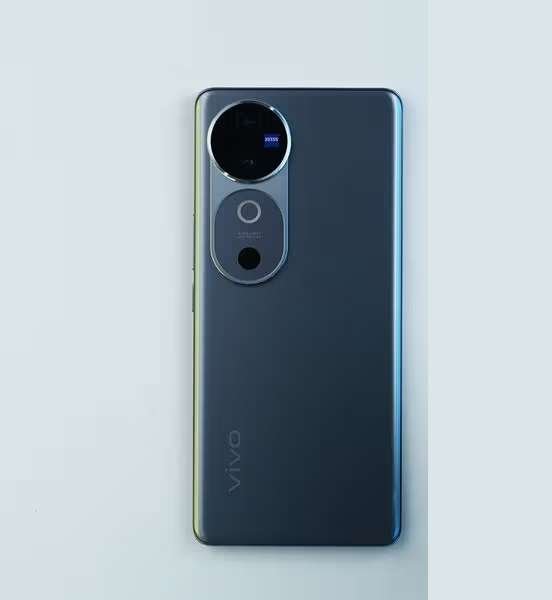
Verdict
With significant improvements, the V40 is a respectable mid-range choice. The phone, with its ZEISS goodness, provides a better experience with the portrait camera than its predecessor, however it is not always able to catch details in specific situations. The V40 has several advantages, such as a long battery life, a brilliant and vibrant AMOLED display, and a stylish appearance. However, because Vivo kept the same chipset in the phone as its predecessor, some phones perform better than the phone.
Design and display

This 6.78-inch AMOLED display has a peak brightness of 4,500 nits, a refresh rate of 120 Hz, and a screen resolution of 1260 x 2800 pixels. The phone’s display has an amazing pixel density of 453 ppi, which makes it seem sharp and provide excellent viewing angles. The phone is incredibly durable, even in full sunlight. Some people may find the curved display screen appealing or not, based on their individual tastes. As I’ve shown in the majority of my recent evaluations, I’ve recently come to favor flat panels because viewing angles are superior and there are no mistouches. Nevertheless, the flowing appearance on the display’s sides can provide a more immersive experience if ambient light isn’t a big problem.
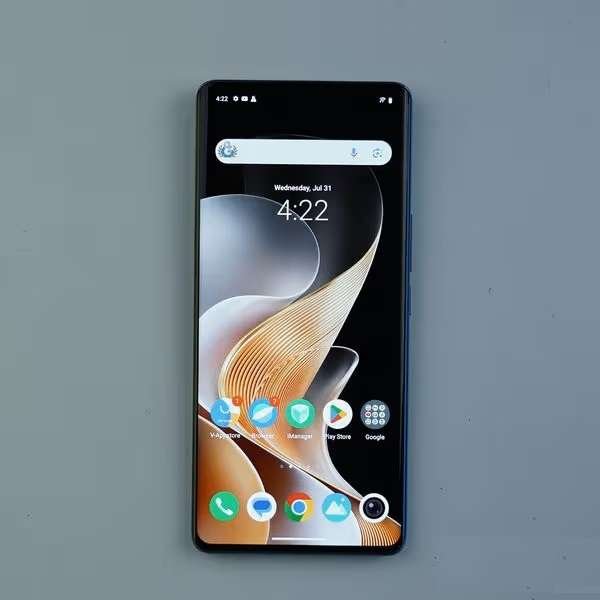
The V40 excels in the display department, boasting a responsive panel with bright colors and a strong contrast ratio.
Cameras
The V40 comes with two cameras installed on its back: a 50MP primary sensor with an f/1.9 aperture, a 1/1.55-inch sensor, PDAF, and support for OIS. An ultra-wide 50MP camera with an AF system, 1/2.76-inch sensor size, and 119-degree field of view supports the primary photographer. This time around, the V40 has cameras bearing the ZEISS brand, as I previously stated. The manufacturer has added “Studio Quality Aura Light” to the phone to give a more natural flash. Recall that the Aura Light was also included in the V30 series, albeit it was shaped like a rounded square. This time, the light is circular, but the purpose is still the same: to give you a natural flash that, in contrast to conventional flash, may enhance low-light photos without overexposing them.

With the ZEISS multi-focal portrait, you can take some really nice portrait photos in a variety of genres and at different zoom levels (Landscape Portrait: 24 mm, Street Portrait: 35 mm, Natural/Classic Portrait: 50 mm), and the edge recognition was accurate. The phone’s ability to capture portrait photos continuously amazed me, and it may be the best argument in favor of its cameras. The various ZEISS Style Bokeh effects that are accessible in the portrait mode—Cine-flare, Planar, Sonnar, Sonar, Biotar, and so on—are enjoyable to work with, and this camera mode is constantly engaging because to the various LUTs that are offered for various festivals.
In terms of aesthetics, the V40 produces some really nice images regardless of the lighting. There’s a reason why I used the word “aesthetically” explicitly. When you enlarge on some of the phone’s camera samples, you’ll find that they frequently lack the fine details that some other phones in this price range are able to capture. This is particularly apparent in the direction of the image’s edge. You can first view a few of the camera samples I took with the phone before we go into more detail about how well it performed in comparison to other cameras.
Daylight
The V40 blurred some of the things on the outside of the frame in the daytime image, while the Motorola outside 50 Pro (review) enhanced the colors too much for my taste.
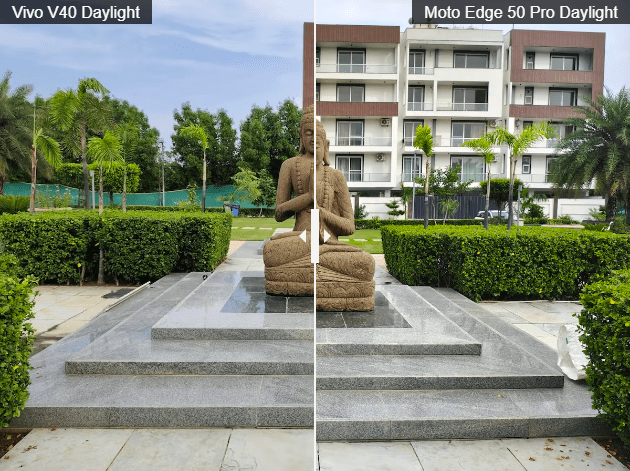
The V40 blurred some of the things on the outside of the frame in the daytime image, while the Motorola outside 50 Pro (review) enhanced the colors too much for my taste.

Ultrawide
The oversaturated image that the Edge 50 Pro captured in the ultrawide shot drastically altered the appearance of the frame. However, the V40 continued to have trouble catching details and only slightly improved the colors compared to the Edge 50 Pro.
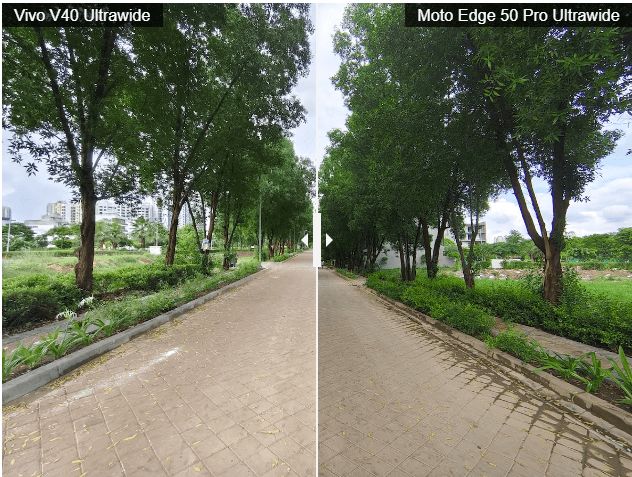
Unexpectedly, the Realme GT 6T captured the least detailed image in this snap, and the whole image was quite grainy. The Vivo was the best-performing phone in this comparison in terms of color accuracy and even in terms of details, though details at the frame’s edge were still dubious.

Low-light (night mode)
The V40 overexposed and overexposed the low-light images, producing extremely brilliant and unrealistic-looking photos. By contrast, the Edge 50 Pro performed better in managing the exposure intensity.
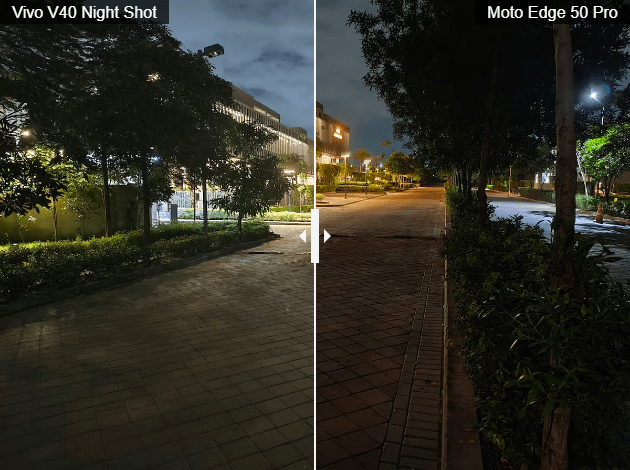
While the Realme GT 6T did not overexpose like the V40, it also did not yield images with as much information as the Edge 50 Pro. All things considered, the Edge 50 Pro produced the greatest images when shooting in low light or at night.

Performance and software
The Vivo V40 is significantly improved over its predecessor in many important ways, however there is one area where it is unchanged: processor selection. The Snapdragon 7 Gen 3 chipset, which powers the device, is a given given how many OEMs continue to use this SoC in this pricing range. The phone I received has 8GB of RAM and 128GB of storage, but it is possible to get up to 12GB of LPDDR4X RAM and 512GB of UFS 2.2 storage on it. With up to 12GB of additional RAM, the phone can handle even the most taxing tasks. It can also run over 40 programs in the background so you won’t have to worry about your apps continually refreshing.

To gauge the phone’s performance against its top competitors, we pitted it against the Realme GT 6T and the Motorola Edge 50 Pro. In this comparison, we started by performing the AnTuTu benchmark test on all these phones. As the AnTuTu benchmark score is a quantitative measure of a device’s overall performance, it evaluates various aspects of the device’s hardware and software capabilities through a series of tests.

This test revealed no surprises, as the Realme GT 6T handily defeated the Edge 50 Pro and the V40 thanks to its Snapdragon 7+ Gen 3 chipset. Even with the same processor, the Edge 50 Pro performed somewhat higher on this benchmark than the V40.
We then used these identical devices to run the Geekbench test. Through a variety of tests, the Geekbench score evaluates a device’s CPU and GPU performance to give an overall assessment of its processing capacity and effectiveness when performing both single- and multi-core tasks. Here too, the GT 6T managed to outperform both the other phones.
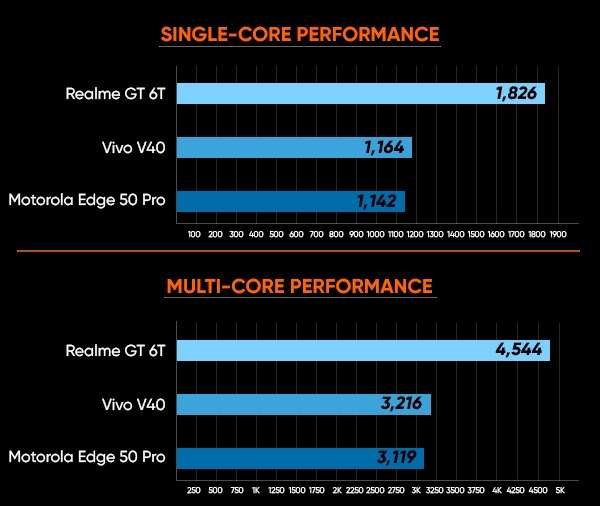
In this specific benchmark test, though, the V40 outperformed the Edge 50 Pro, suggesting that it is more adept at handling CPU-intensive tasks.
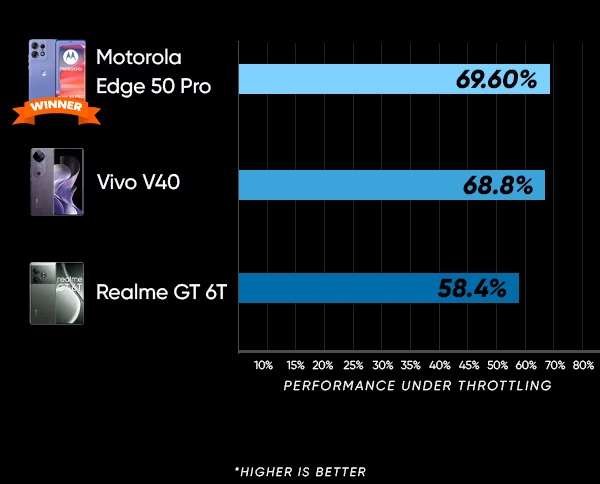
Speaking of efficiency, we next put these phones through the Burnout test to see how they handled pressure. The Edge 50 Pro was victorious in this test, with the V40 trailing closely behind. This test resulted in a significant reduction in the GT 6T’s performance.

Now for the software: the V40 comes pre-installed with FunTouchOS 14, which is based on Android 14. Although there are about 51 pre-installed apps on the phone, I never felt like I was being forced to use any of them. The phone is a pleasure to use thanks to its fast user interface animations and 120Hz refresh rate. There aren’t any significant differences between the FunTouchOS 14 and the V30 or V40 Pro at this point. This entails that you receive programs like Jovi Home, an AI assistant that makes recommendations based on usage patterns, iManager, a cleanup tool, and V-Appstore, Vivo’s own app store.
Battery life and charging speeds
With its 5,500mAh battery and compatibility for 80W rapid charging, the V40 was able to provide me with a respectable backup during regular use. It’s typically a positive indicator when I have some battery remaining at the end of the day. The phone’s battery life in our PCMark test was 13 hours. This backup is comparable to several other phones in this price range.

In our gaming test, the phone’s cumulative battery percentage dropped by 16% when we played three well-known games for 30 minutes apiece—BGMI, Real Racing 3, and Call of Duty: Mobile. Compared to competitors, this is on the lower end. This indicates that the phone provides improved battery life even when doing taxing tasks.

Final verdict
The Vivo V40 maintains the SoC of its predecessor while bringing some noticeable advancements to the table. This indicates that the phone is more costly than the Realme GT 6T, which has significantly more horsepower, at a starting price of Rs 34,999. Nevertheless, the V40 has respectable optics, a bright, lively display, a sleek, and slim design, and a strong battery life. The camera software is excellent, however I believe the overall software is lacking in functionality compared to its competitors. Despite being a phone primarily focused on the camera, bear in mind that the V40 has trouble capturing details in some photos. It’s worth considering the V40 if you can get over this.
Editor’s rating: 7.5 / 10
Reasons to buy
- The phone is capable of taking some impressive portrait shots
- The vibrant display offers a peak brightness of 4500 nits
- Despite being a slim smartphone, the V40 packs a massive 5500mAh battery
Reasons not to buy
- The phone carries the same chipset as its predecessor
- The cameras often struggle to capture details
Key Specs
vivo V40
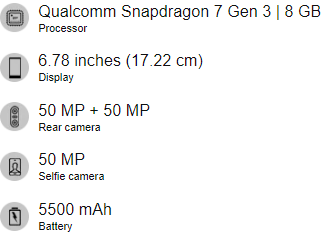
vivo V40 Images
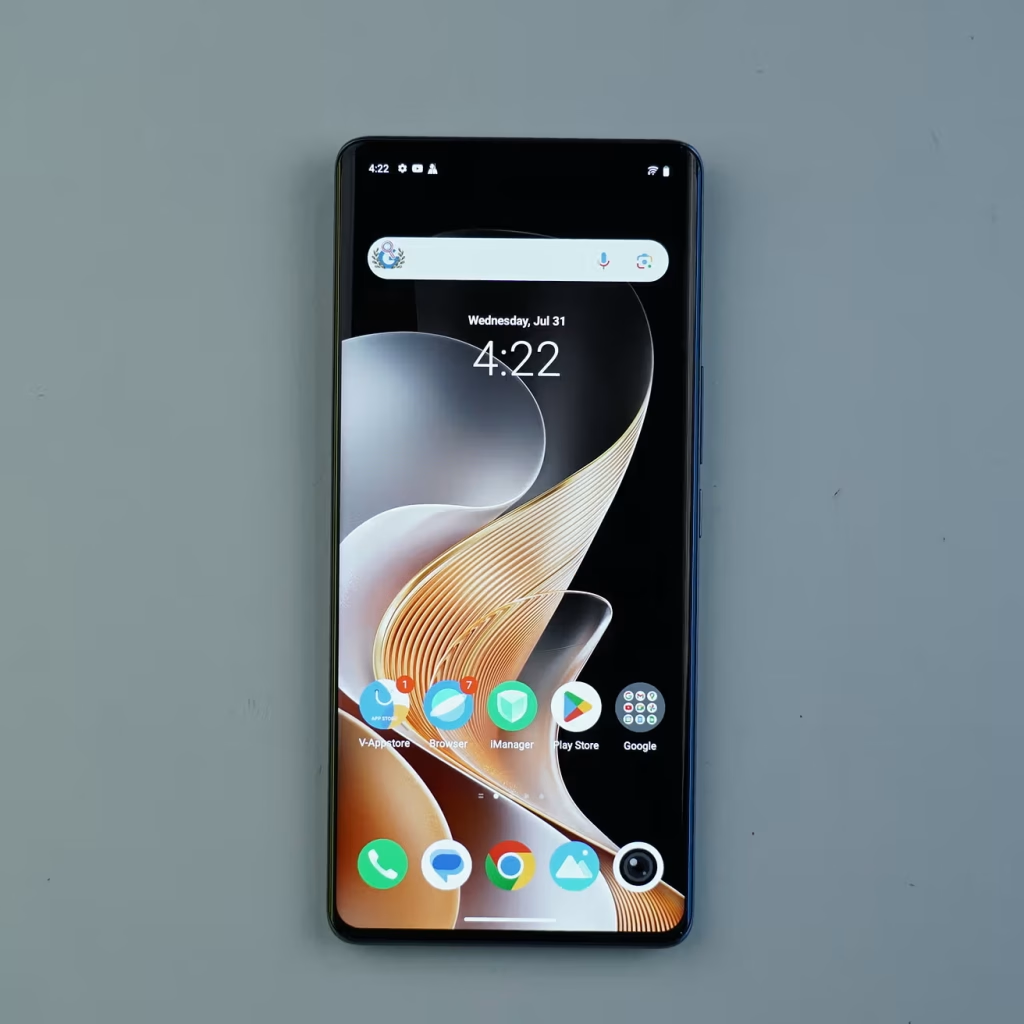
Trending News
Phones launching in India this week: Realme 13 Pro, Nothing Phone (2a) Plus, Motorola Edge 50, and more...

Phones launching in India this week: Realme 13 Pro, Nothing Phone (2a) Plus, Motorola Edge 50, and more...

Phones launching in India this week: Realme 13 Pro, Nothing Phone (2a) Plus, Motorola Edge 50, and more...

Phones launching in India this week: Realme 13 Pro, Nothing Phone (2a) Plus, Motorola Edge 50, and more...

Phones launching in India this week: Realme 13 Pro, Nothing Phone (2a) Plus, Motorola Edge 50, and more...

Phones launching in India this week: Realme 13 Pro, Nothing Phone (2a) Plus, Motorola Edge 50, and more...

Phones launching in India this week: Realme 13 Pro, Nothing Phone (2a) Plus, Motorola Edge 50, and more...

Phones launching in India this week: Realme 13 Pro, Nothing Phone (2a) Plus, Motorola Edge 50, and more...

Popular Phones
Motorola Edge 50 Fusion
Motorola Edge 50 Fusion
Motorola Edge 50 Fusion
Motorola Edge 50 Fusion
Motorola Edge 50 Fusion
Motorola Edge 50 Fusion
Motorola Edge 50 Fusion
Motorola Edge 50 Fusion
Motorola Edge 50 Fusion
Motorola Edge 50 Fusion
Latest Reviews
Phones launching in India this week: Realme 13 Pro, Nothing Phone (2a) Plus, Motorola Edge 50, and more...

Phones launching in India this week: Realme 13 Pro, Nothing Phone (2a) Plus, Motorola Edge 50, and more...

Phones launching in India this week: Realme 13 Pro, Nothing Phone (2a) Plus, Motorola Edge 50, and more...

